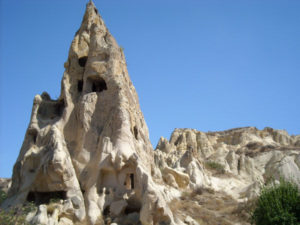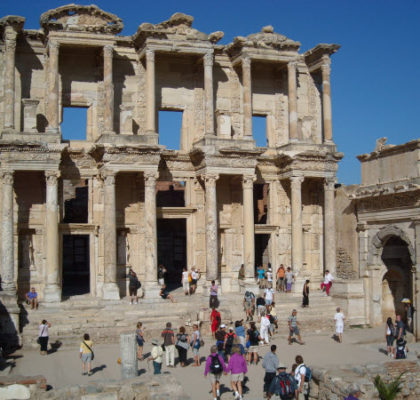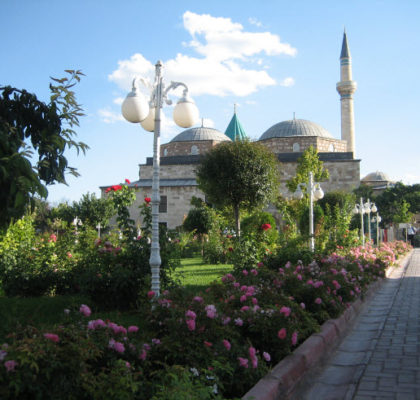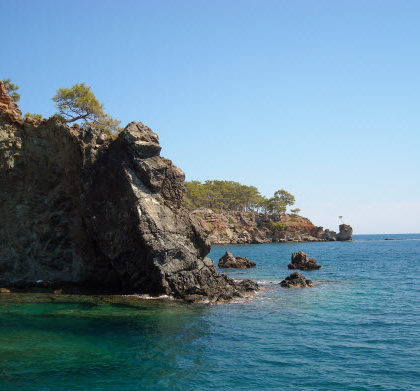- Destination Updates
- Testing the Compression Straps
- Auspicious Beginnings
- Even Old New York was Once New Amsterdam
- Accidentally in Asia
- European Capital of Culture
- Father of the Turks
- Morning in Cappadocia
- Ask an Imam
- Cleaning Up
- The Cast
- The Long Goodbye
- Our Fearless Leader
- Survivor: Istanbul Finalists
- Asia Minor Gallery
- Istanbul Notes
- Ankara Notes
- Cappadocia Notes
- Antalya Notes
- Konya Notes
- Ephesus Notes

This central Anatolian region is best known for the cliff dwellings and churches carved out of the volcanic rock. Erosion from wind and rain created interesting formations, including  the oft-photographed “fairy chimneys” (as photographed oft-again on the right).
the oft-photographed “fairy chimneys” (as photographed oft-again on the right).
The Göreme Open Air Museum (a UNESCO World Heritage site, thank you very much) contains a number of churches carved out of the cliffsides by the monastic community that lived there, so my sources cite, from the 11th Century. The interior decorations vary from simple pillars and primitive designs to elaborate frescoes on the walls and ceilings – some still very vivid even after centuries of tourists.
Some tourists were less benign. Fueled by a proscription on art depicting the human form, Muslim vandals scratched out the eyes of the images they could reach. What remains are haunting illustrations of saints and saviors with vacant stares or etched milky tears running down their cheeks.
Other options to underground living were witnessed at Kaymakli, one of the subterranean cities built to guard against invaders. The stables and wineries indicated the citizens were prepared to stay a while. The large stone plugs which could be rolled over entryways to keep unwanted guests out showed they valued the exclusivity of their gated community.
Cappadocia by Air

 A popular way to view the unique landscape in Cappadocia is by air via hot-air balloon. The ideal time to go is at dawn: to be aloft as the sun rises and illuminates the rock formations and dwelling.
A popular way to view the unique landscape in Cappadocia is by air via hot-air balloon. The ideal time to go is at dawn: to be aloft as the sun rises and illuminates the rock formations and dwelling.
Needless to say, this is not an undiscovered concept. Although several dozen other balloons joined us in the Anatolian sky that morning, it was not unpleasant to share the view. If you have the opportunity and the inclination, this is a lot of fun. Very recommended.
Details of our early morning excursion are on our blog post.
The Exchange of Populations
Cappadocia was the first place that the concept of the population exchange became evident. The town of Mustafapasa, where we based, used to be known as Sinasos when it was the home of a large Greek community. The Greek homes and the churches remain. The Greeks – except for the occasional tourist – are gone. In the early 1920s, the agreed-upon way to end the potential ethnic strife after Turkish independence was to transfer populations: Greeks living in Turkey were sent to Greece, Turks living in Greece were relocated to Turkey. Between 1.5 and 2 million people were displaced, many to “native” countries they had never visited. Some villages were never re-populated. Some enterprising individuals saw an opportunity in departing populations. The owner of a lovely guest home once boasted that his grandfather purchased the house from a departing Greek family for only 10 lira.
This entry was posted in Asia Minor

